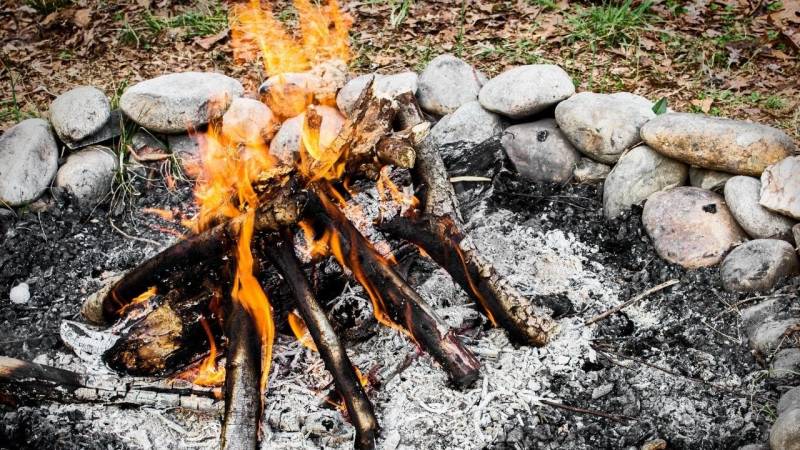
The Bushcraft fire pit: How to set it up perfectly - the complete guide
👉 The key facts from this guide
- Choose the location of your fire pit carefully. It should be at least three meters away from your shelter and not near dry bushes, grasslands, or other flammable areas.
- Keep your fire small and safe. Use a suitable border of non-flammable material, such as stones, to prevent your fire from creeping beyond its intended boundary.
- Use the right materials. Avoid burning trash, treated wood, and toxic plants as they can release poisonous fumes.
- Build a fireplace. With a few carefully selected stones, a digging stick, and earth, you can build an efficient fire.
- Follow the "leave no trace" rule. Leave your fire pit so that nothing of it is visible anymore. Completely extinguish the fire, distribute the ashes, and cover the area with earth, leaves, and needles.
What if Ray Mears came to your bushcraft camp and said:
Your fire pit is great. It poses no risk, it's stylish and efficient.
And in fact, it's possible. Ray Mears probably won't actually show up, but you can build the perfect bushcraft fire pit in less than 30 minutes.
The best news? It's not complicated, and I'll show you everything in just a few minutes.
Let's get started.
A bad fire pit is worse than none at all
Survival skills all begin in your head and your initial decision to fight or give up.
Your first goal is to protect yourself from nature (weather, cold/hot, animals, etc.).
But not only protection is important, but also a safe and functioning fire pit. In some situations, a fire even takes higher priority.
If you don't know the rules yet, check here: "The 7 most important survival tips for survival"
Your ability to build a safe shelter with fire for warmth is a critical survival skill.
The point is: It can be worse to build the fire pit wrong than not building one at all.
I made some mistakes in the past, and now I've created this guide to give you the tools you need to build a fire pit correctly and efficiently.
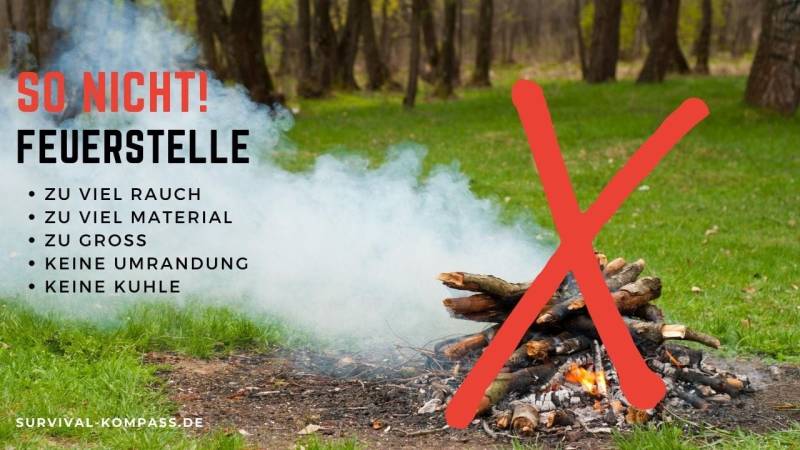
Do I even need a fire?
Let's set aside the legal aspects of fire in Germany and consider whether you require a fire.
In warm summer weather, you might think that a hot fire is unnecessary. But that's wrong, unless it is 30 degrees at night.
Whether it's hot or cold, when the sun goes down, it gets cold.
The fact is: you can get hypothermia even at 10° C.
And if it's windy or raining, the temperature doesn't even need to be low - then you'll get colder faster.
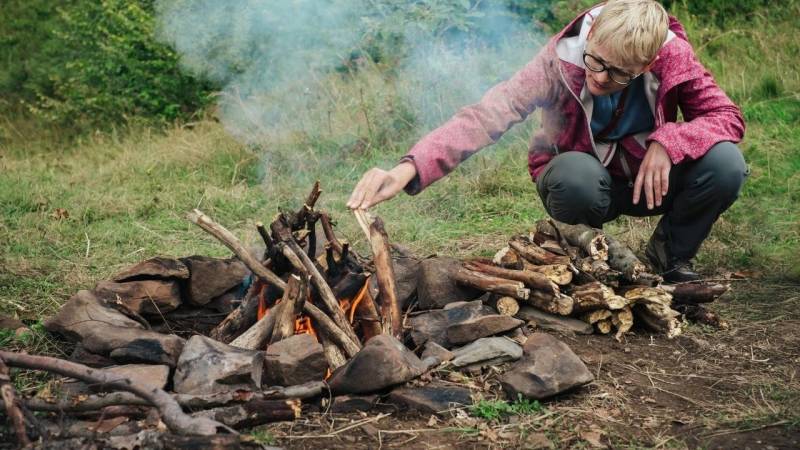
At a fire pit, you not only warm yourself, but also cook on it. If you have camping gear with you, such as an outdoor stove, it's easy. If not, you'll have to rely on a campfire.
Recommended reading on the topic: Outdoor Stove - Which type is right for you?
The first rule of fire: finding the right location
Use your common sense to make the most of the building materials and your wilderness camp when planning a fire pit.
Consider the following:
- Distance: Place your campfire at least three meters away from your shelter.
- Wind direction: Make sure the wind is not blowing the smoke and sparks into your shelter. A simple rule of thumb is that the wind usually comes from the west in most parts of the Northern Hemisphere.
- Rocks: Never build your fire under a rocky overhang or in a cave. The heat can cause the rock to expand, break, and potentially fall on you and your fire.
- Flammables: Never start a fire near dry bushes, grasslands, or other flammable areas.
- Level ground: Find a flat spot so that your fire does not slide or roll away.
- Smoke: Smoke must be able to escape. Ideally, your flame is outdoors. Inhaling smoke is dangerous, and even if you don't see a visible cloud, you can still be poisoned by carbon monoxide.
- Animals: If you find animal droppings or trails, there may be animals coming back to that spot – it's better to choose another location.
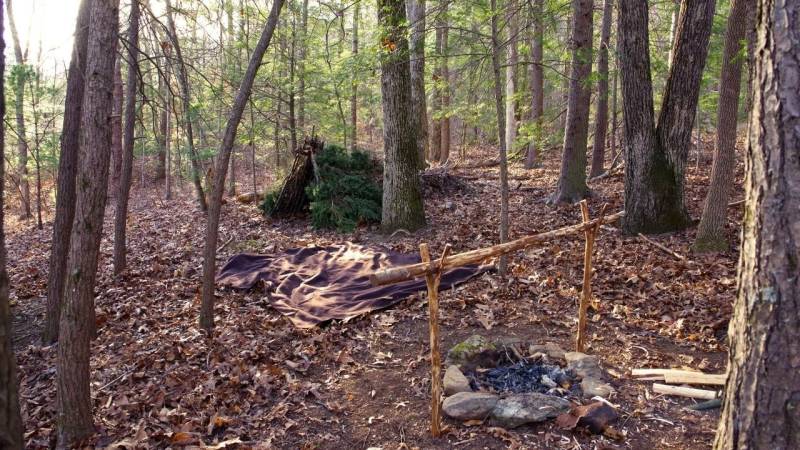
The second fire rule: Keep your fire small and safe
Even though it's the second rule, it's just as important as the first rule.
It is essential that you are not only warm and protected, but also safe. Fire provides a lot of comfort, but it is also very dangerous. Please make sure to respect the nature around you by properly taking care of your fire.
For some of you, these things may seem obvious. But to be thorough, I have included all beginner's mistakes.
- Do not start a forest fire: Your campfire should be contained, and you need to keep an eye on it. You need a suitable border made of non-flammable material. If necessary, create a raised earth wall. But what you really require are rocks. Not only do they provide heat, but they also prevent your fire from creeping beyond the boundary.
- Perhaps this is self-explanatory, but when building your campfire, do not use flammable materials. Wet wood may seem safe, but remember that the fire will draw out the moisture from this wood all night long, and it will eventually no longer be wet wood. Once it dries out, it becomes the perfect fuel.
- You should always use rocks to build your campfire. Collect sand if necessary, but never use flammable material to build your campfire.
- Look up: Look up and see what's hanging or living there. Are there branches or other flammable materials? Of course, you would rather not set nearby trees on fire. But not only that: there could also be bird nests there, and it would be inconsiderate to the animals.
- Look down: Please don't start a root fire. Remove all roots that you find in your fire pit. If your excavated hole is full of roots, consider whether a different location might be better.
- Be vigilant: Keep an eye on the fire. It's not wise to leave a raging fire behind when you leave camp. Put it out before you go. Furthermore, you'll need to sleep at some point. But wait until the flames have died down. What's left is hot embers. Although they still pose a fire hazard, it's less likely that they'll start an uncontrollable fire.
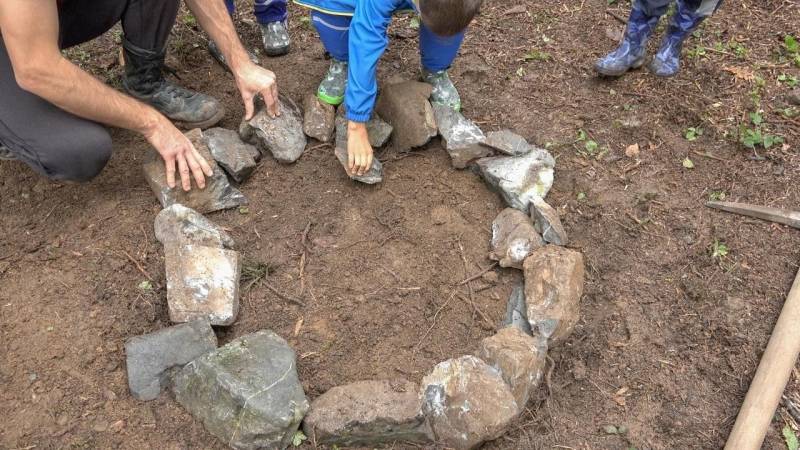
All stones used should come from a dry location. Wet and moist stones can be dangerous when heated by the fire and explode.
Read also
Bushcraft without frustration: These 12 mistakes you should avoid as a beginner – You are starting with bushcraft and want to avoid typical beginner mistakes? Here you will learn what pitfalls there are and how to avoid them.
The third fire rule: Use the right materials
Occasionally, you may have to use all kinds of fuels. Especially when your firewood is running low in Bushcrafting.
However, you have to be smart and only use suitable fuel. I'll list a few for you that you should never burn.
- Garbage: It is terrible how some fire pits look. Rubber, bags, plastic, aluminum foil, and other artificial materials. These materials release toxic fumes and harm nature.
- Treated woods: You find an old pallet and think: Wonderful, I can burn it. Think again. All industrially produced woods for outdoor use are very likely chemically treated. This prevents the wood from rotting too quickly. These chemicals become dangerous when burned. So, as much as possible, stick to natural wood.
- Poisonous plants: Poison ivy, oak, sumac, etc. Please realize that firewood sold in stores is well-dried. This is not always the case with wood from the forest. For example, burning oak wood produces toxic cyanide, which can transfer to your food. Other poisonous types of wood can strongly irritate your lungs due to their essential oils.
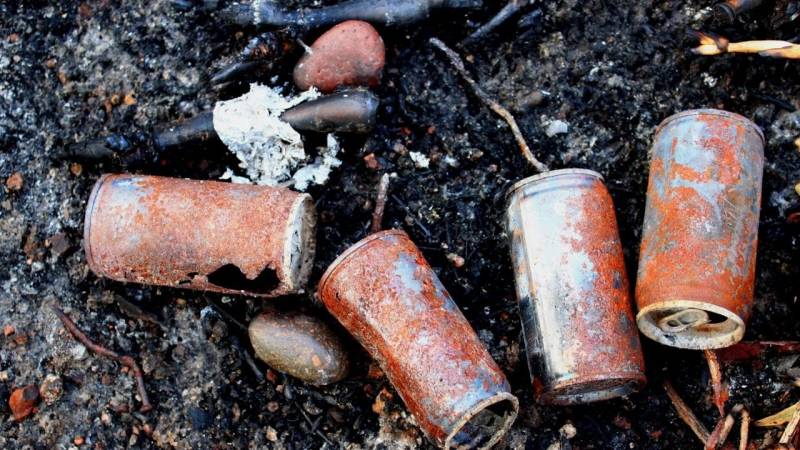
Build a genius fireplace
If you had the time and materials to build the perfect fire in your wilderness camp, what would it look like?
It surely depends heavily on the materials available to you.
But with a few carefully selected rocks, a digging stick, and dirt, you can build my favorite fire that our ancestors would be proud of.
After finding your perfect location, start building the fireplace. Do it like this:
- Dig a hole about 20 to 30 cm deep with a diameter of about 60 cm. This is your fire pit, in which you will place the embers and charcoal.
- Next, dig a trench away from the fire pit that is about 60 cm long and as deep as the fire pit. Your fire pit should be in the direction of the wind.
- Cover the fire pit and the trench with stones and earth.
- Then find a flat and heat-resistant stone to cover almost the entire trench. Leave an opening at the end of the trench for smoke to escape.
- Ideally, build a small chimney out of stones at the end of the trench. The chimney will help the fire draw better.
When you're finished, your fire pit will be shaped like a keyhole. As shown in the picture at the bottom, this type of fire pit is called a "keyhole fire pit."
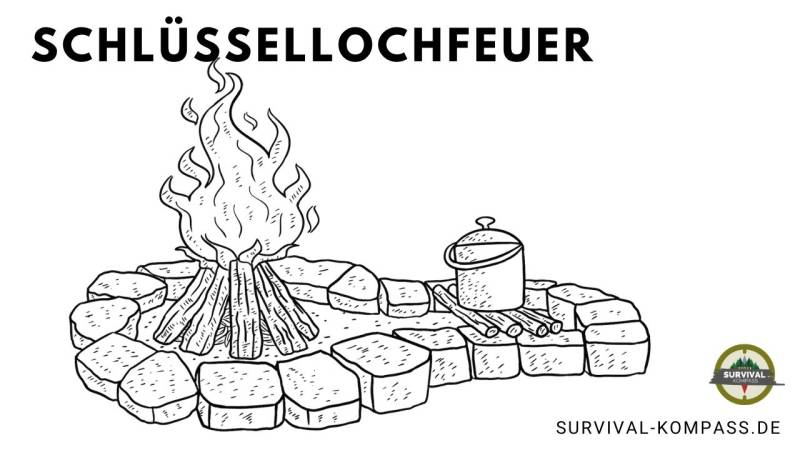
You will light your fire in the pit, for example a star or teepee fire. This is where you can warm yourself up.
Once you have enough charcoal and embers, transport them to the end of your trench with a stick. Here, you can cook in peace on the stone slab in the narrow area. Pots and pans can also be placed here.
You can use the chimney for smoking (not shown in the picture). For example, you can cook on an open fire with a pot hanger.
In this short video, I show you how to build another pot hanger. This one is extremely versatile and flexible.
If you want to know in detail how it is built, I invite you to the Wildimpuls Program (in German). There, we build this pot hanger step by step in a week-long mission.
The "Leave no trace" rule
You should leave your fire pit in such a way that nothing is visible anymore.
Clean enough that not even the FBI could find a trace if they were looking for you.
How to do it? Quite simply:
- Let the fire burn out completely
- Extinguish the ashes with water and make a slurry
- Distribute the slurry made of water and ash over a large area
- Remove the stones, cover the fire pit with soil, leaves, and needles
I made a short video about it. Check it out here:
Read also
The 7 Leave No Trace Principles and their Application: Your Guide to Environmentally Conscious Outdoor Behavior – Discover how the Leave-no-Trace principle can revolutionize your outdoor experience. Protect what you love and read more about this environmental protection.
Final thoughts
I know that most people don't think about this topic.
Here are some deterrent examples:
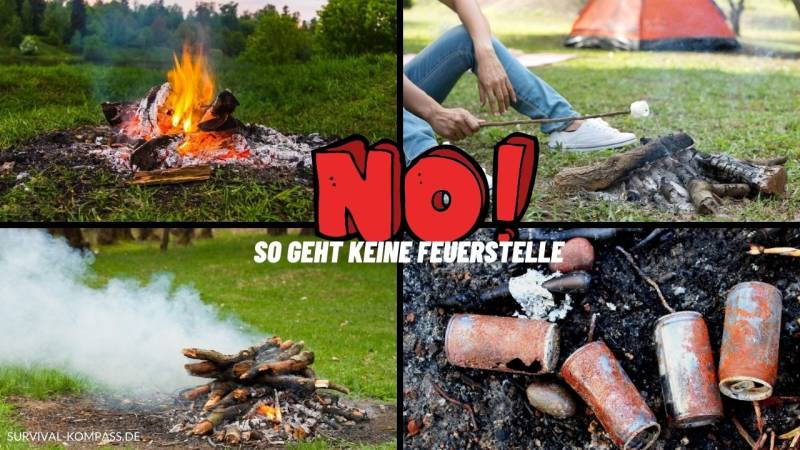
But now you're here, and you've finished reading - incredible!
You now know what to consider when choosing a location for a fire pit, what safety measures to take, and what materials to use as fuel.
In addition, you now have the knowledge to build a great fire pit with a chimney and cooking plate, and how to make it disappear without a trace.
You're well-prepared for your next trip with a campfire. You can learn even more about making fires in my book "Die Feuer-Fibel" (in German).
And now go out and put your knowledge into practice. I wish you many good experiences in nature.


Author of the guide
Martin Gebhardt
Hey, I'm Martin. On my blog, you will learn the basics and numerous details about living in the wild. I think survival, bushcraft and the good life in nature are the keys to happiness. Find me here on Instagram or on YouTube. You can find more about my mission on the About Me page.
Was this guide helpful?
31 people found this guide helpful.
5.00 out of 5 points (31 Ratings)
Comments (0)
This post may contain affiliate links. So if you click on the links and make a purchase, I will receive a small commission at no additional cost to you. Click here, to learn more about it.


